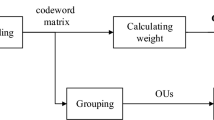Abstract
Raw audios contain significant amount of redundancy which can be used for steganographic purposes. But practically most audios are stored and transmitted in the compressed formats. In this paper, we present a MPEG-1 Layer III (MP3) audio CODEC based steganographic method to embed secret message during encoding. The Huffman tables in MP3 standard are first partitioned into three groups. The secret message is then embedded by Huffman table swapping strategy. Instead of fully decoding the stego-audio, the extraction of the secret message can be done just by parsing the side information. The proposed method is designed under the restrictions of the MP3 compression standard without any modifications or additions to the existing standard. Experimental results show that the proposed method can provide much higher capacity than other approaches, while satisfying the low distortion and security requirements for steganography on MP3 audios.








Similar content being viewed by others
References
Bender W, Gruhl D, Morimot N, Liu A (1996) Techniques for data hiding. IBM Syst J 35(3&4):313–336
Cachin C (1998) An information-theoretic model for steganography. Proceedings of 2nd International Workshop on Information Hiding, LNCS 1525:306–318
Cvejic N, Seppanen T (2004) Increasing robustness of LSB audio steganography using a novel embedding method. Proc IEEE Int Conf Inf Technol Coding Comput 2:533–537
ISO/IEC (1993) Information technology—coding of moving pictures and associated audio for digital storage media at up to about 1.5 M bit/s—part 3: audio IS 11172-3
ITU (1998) Methods for objective measurements of perceived audio quality. ITU-R BS.1387
Kim DH, Yang SJ, Chung JH (2004) Additive data insertion into MP3 bitstream using linbits characteristics. Proceedings of IEEE International Conference on Acoustics, Speech, and Signal Processing, 181–184
Koukopoulos D, Stamatiou C (2005) An efficient watermarking method for MP3 audio files. Internatinal Enformatika Conference, Enformatika, Çanakkale, Turkey, pp 154–159
Moghadam N, Sadeghi H (2005) Genetic content-based MP3 audio watermarking in MDCT domain. Internatinal Enformatika Conference, Enformatika, Çanakkale, Turkey, pp 348–351
Nahrstedt N, Qiao L, Dittmann I (1998) Non-invertible watermarking methods for MPEG video and audio. The 6th ACM International Multimedia Conference. Bristol, England, pp 93–98
Neubauer C, Herre J, Brandenburg K (1998) Continuous steganographic data transmission using uncompressed audio. Proceedings of Information Hiding Workshop, pp 208–217
Petitcolas FAP (2002) MP3Stego. http://www.cl.cam.ac.uk/∼fapp2/steganography/mp3stego/index.html
Provos N, Honeyman P (2003) Hide and seek: an introduction to steganography. IEEE Secur Privacy Mag 1(3):32–44
Takagi K, Sakazawa S, Takishima Y (2005) Light weight MP3 watermarking method for mobile terminals. IEICE Transactions on Fundamentals of Electronics, Communications and Computer Sciences, pp 2546–2554
Torrubia A, Mora F (2002) Perceptual cryptography on MPEG-1 Layer III bit-streams. IEEE Trans Consum Electron 48(4):1046–1050
Viswanathan V (2008) Information hiding in wave files through frequency domain. Appl Math Comput 201(1&2):121–127
Wang S, Zhang X, Zhang K (2003) Data hiding in digital audio by frequency domain dithering. Lect Notes Comput Sci 2776:383–394
Westfeld A (2003) Detecting low embedding rates. Lect Notes Comput Sci 2578:324–339
Acknowledgements
This work is supported by the National Natural Science Foundation of China under Grant No. 60873220, Ningbo Natural Science Foundation under Grant No. 2009A610085 and also supported by the Scientific Research Fund of Zhejiang Provincial Education Department under Grant No. 20070974.
Author information
Authors and Affiliations
Corresponding author
Rights and permissions
About this article
Cite this article
Yan, D., Wang, R. Huffman table swapping-based steganograpy for MP3 audio. Multimed Tools Appl 52, 291–305 (2011). https://doi.org/10.1007/s11042-009-0430-5
Published:
Issue Date:
DOI: https://doi.org/10.1007/s11042-009-0430-5



